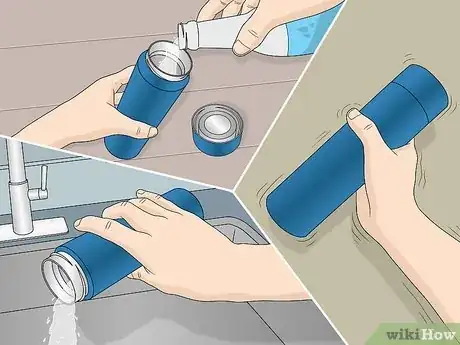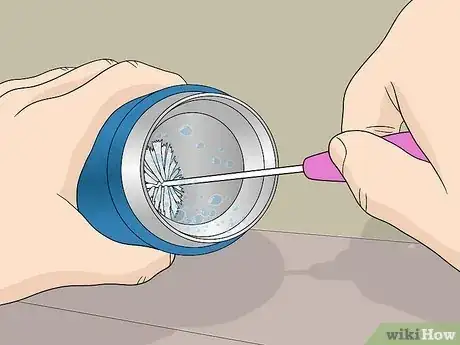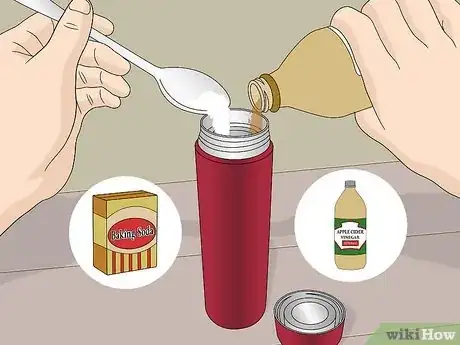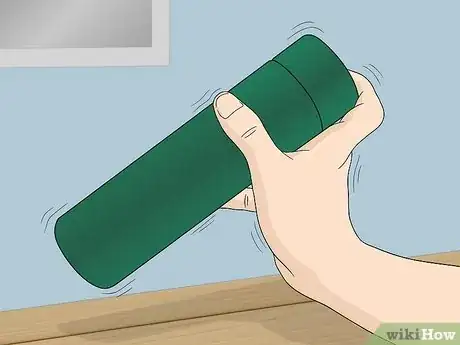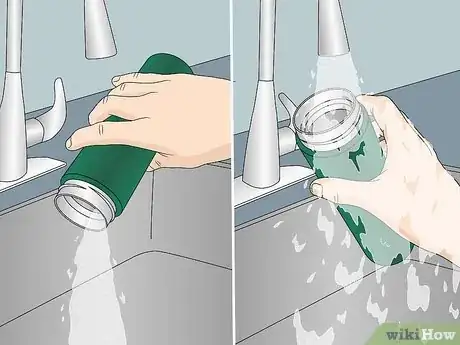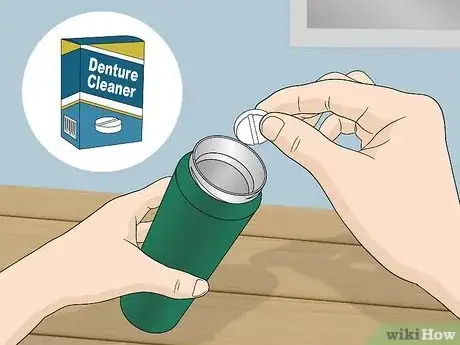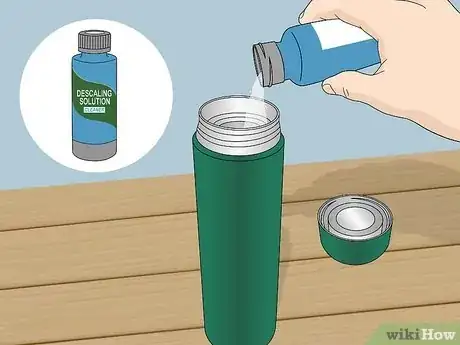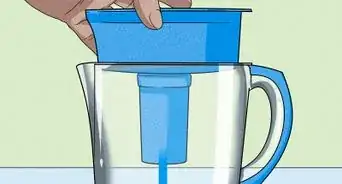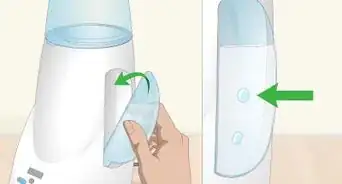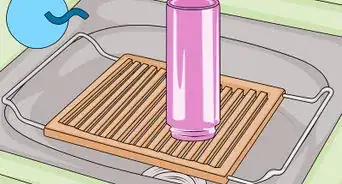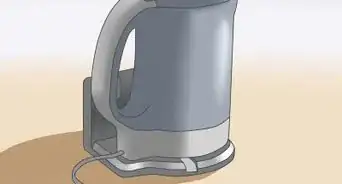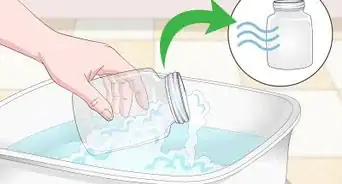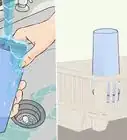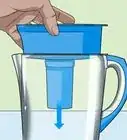This article was co-authored by Chris Willatt. Chris Willatt is the owner and founder of Alpine Maids, a cleaning agency in Denver, Colorado started in 2015. Alpine Maids has received Angie's List Super Service Award for three years in a row since 2016 and has been awarded Colorado's "Top Rated Local House Cleaning" Award in 2018.
There are 8 references cited in this article, which can be found at the bottom of the page.
This article has been viewed 28,622 times.
Vacuum flasks, also called vacuum thermoses, are a handy way of keeping your beverages hot or cold. You can easily clean light dirtiness in your flask with soap and water. To deodorize and clean, try a baking soda and vinegar solution. Use an abrasive, like uncooked rice or eggshells, for extra scrubbing power on the inside of your flask. Apply formulated cleaners, like Oxiclean or denture tablets, for severe stains.
Steps
Using Soap and Water
-
1Use clean water to remove loose buildup. Loose buildup can make your flask seem dirtier than it actually is. Pour a moderate amount of clean water into the vacuum flask. Cap the flask and shake it firmly. Remove the cap and pour the water down the drain.
-
2Add dish soap and water to the flask. Fill the flask with a moderate amount of clean water. Add a few drops of dish soap to the water. Cap the flask and shake it well to clean it. Open the flask and inspect its condition. If there is stubborn buildup, you may need to scrub it away.[1]
- If the water has become dirty, dump it down the drain. Rinse the flask and refill it with clean water and a few drops of dish soap.
- For severely dirty flasks, allow the soapy water to sit for a few minutes. This will allow more time for the soap to break up buildup.
Advertisement -
3Scrub the flask if necessary. To remove stubborn buildup from the inside of flasks, you may need a scrubbing tool. Because some vacuum flasks may have narrow top openings, small, long handled scrubbers or toothbrushes may work best.
- Specialty bottle brushes are available at most grocery stores and drug stores. Look for these in the “baby” or “infant” section of the store.[2]
- If you don’t have a suitable handled scrubber, wrap or tie a washcloth to a wooden spoon. Scrub the insides of the flask with the cloth wrapped spoon.
-
4Rinse the flask and repeat this process as needed. When the inside of the flask looks clean, pour the cleaning solution down the drain. Rinse the flask to remove soap and loosened buildup. Allow the flask to air dry completely before storing it.
- Storing a vacuum flask while still wet or capped could cause it to smell musty. To remove mustiness, use the process described for deodorizing and cleaning with baking soda and vinegar.[3]
Deodorizing with Baking Soda and Vinegar
-
1Combine baking soda and apple cider vinegar in the flask. Rinse your flask to remove any loose foreign matter already inside it. Pour out the rinse water and add 1 or 2 tbsp (15 to 30 ml) of baking soda to the flask. Combine a moderate amount of vinegar or hydrogen peroxide with the soda.
- Most normal sized flasks will only need about an inch (2½ cm) of vinegar in the bottom of the flask to be effectively cleaned.
- Distilled white vinegar can be used in place of apple cider vinegar. However, apple cider vinegar is more acidic, making it more suitable as a cleaner.[4]
- The reaction between the vinegar and the baking soda should cause fizzing and bubbling. This is completely natural. Wait until this reaction has stopped before going further.[5]
-
2Add boiling water to the solution. Check your vacuum flask user instructions before doing so. Some flasks may only be intended for cool substances and could be damaged by boiling water. Pour boiling water into the flask until it is half to three-quarter’s full.
- To boost the cleaning power of the soda/vinegar solution, let it sit in the flask for a few minutes before giving it a thorough shaking.[6]
-
3Shake the flask. When the foaming of the soda/vinegar solution has stopped, cap the flask firmly. Shake the flask lightly, then remove the cap to release pressure. Recap the flask, then shake it thoroughly for a minute or so to clean and deodorize it.
- Capping the flask too soon could cause pressure to build up from the baking soda/vinegar reaction, which may damage your flask or cause the top to suddenly pop free.[7]
-
4Dispose of the solution and reapply it as necessary. Remove the cap from the flask and inspect its inside. If the flask is still dirty or musty, repeat this process. Leave the uncapped flask out overnight to air dry. Flasks should be stored uncapped when completely dry.[8]
Removing Buildup with Rice or Eggshells
-
1Add water, uncooked rice, and a mild detergent to the flask. Flush the flask with clean water. Dump the water down the drain and refill it with a moderate amount of clean water. Insert a small amount (roughly a handful) of uncooked rice to the water. Add a few drops of a mild detergent, like dish soap.[9]
- In place of uncooked rice, you can substitute crushed eggshells. Boil an egg to clean the shells. Peel the egg and crush the shells with your clean hands. Add these to the flask in the same fashion and amount as uncooked rice.[10]
-
2Shake the flask thoroughly. Cap the flask firmly to prevent leaking. Use a variety of motions while shaking the flask: swirl the solution back and forth, tip the bottle upside down and rightside up. Using firm motions will clean the inside best.[11]
-
3Empty the flask and rinse it. Dump the cleaning solution outside or down a drain. Rinse the flask thoroughly to remove any remaining rice (or eggshells) and soap. Inspect the flask for remaining dirtiness. If it is still dirty, repeat this process.
- When clean, air dry the flask for about eight hours or overnight, then store the flask uncapped. This will prevent your flask from developing an unpleasant odor.[12]
Using Cleaners on Tough Stains
-
1Brighten discolored flasks with Oxiclean. Rinse the flask as you would for a normal cleaning, then add roughly a half tsp (5 ml) of Oxiclean to the flask. Pour hot water into the flask until it’s nearly full. After a short while, empty the flask and rinse it thoroughly. Air dry the flask and store it as you would normally.
- For the best results, keep the solution in the flask for at least eight hours or let it sit in the flask overnight.
- This technique is also especially useful for removing difficult stains and stubborn odors from flasks.
- Take care to completely remove the Oxiclean from the flask. Remaining cleaner may cause stomach irritation, sickness, or a bad taste.[13]
-
2Remove buildup with denture tablets. Check the size of your thermos. For every 2 cups (473 ml) your flask can hold, use a single denture tablet. Put your flask in a sink and fill it with hot water. Let it sit capless for several hours. Dump out the cleaner afterwards and thoroughly rinse the flask.
- Denture tablets are formulated to cleanse ingrained stains, making them useful for flask cleaning.
- Denture tablets will likely fizz and foam quite a bit. To prevent overflowing solution from making a mess, you clean flasks with this technique over a sink or outside.
- Flasks with stubborn buildup may require a little scrubbing action. In the same fashion described for general flask washing, scrub the inside of the flask with a toothbrush, bottle brush, or washcloth.[14]
-
3Use a descaling agent to clean the flask. Common descaling cleaners include CLR, Mineral Magic, and Renegite. Apply these to your flask according to the cleaner’s label directions. Rinse the flask several times after cleaning to ensure no cleaner remains.[15]
- Be careful when using harsh cleaners on your flask. In some cases, these may cause damage to your flask.
- Harsh cleaners can be harmful when ingested. To prevent indigestion, sickness, or a bad taste in your flask, be sure to rinse the flask well.
Expert Q&A
-
QuestionHow do you get the smell out of a vacuum flask?
 Chris WillattChris Willatt is the owner and founder of Alpine Maids, a cleaning agency in Denver, Colorado started in 2015. Alpine Maids has received Angie's List Super Service Award for three years in a row since 2016 and has been awarded Colorado's "Top Rated Local House Cleaning" Award in 2018.
Chris WillattChris Willatt is the owner and founder of Alpine Maids, a cleaning agency in Denver, Colorado started in 2015. Alpine Maids has received Angie's List Super Service Award for three years in a row since 2016 and has been awarded Colorado's "Top Rated Local House Cleaning" Award in 2018.
House Cleaning Professional Fill it with a mixture of 5 parts water and 1 part vinegar. Let it soak overnight, then wash it out in the sink the next morning. Basically, it is the same way that you would clean a coffee pot.
Fill it with a mixture of 5 parts water and 1 part vinegar. Let it soak overnight, then wash it out in the sink the next morning. Basically, it is the same way that you would clean a coffee pot.
Warnings
- Cleaners that foam, bubble, or fizz can cause pressure to build up inside of capped flasks. Too much pressure could cause damage to the flask or the lid to pop free suddenly.⧼thumbs_response⧽
- Some flasks may require special cleaning procedures and products to preserve its condition. Always follow the care instructions for the best results.⧼thumbs_response⧽
Things You’ll Need
Washing with Soap and Water
- Dish soap
- Washcloth (optional)
- Scrubbing tool (like a bottle brush or toothbrush; optional)
- Wooden spoon (optional)
Deodorizing and Cleaning with Baking Soda and Vinegar
- Apple cider vinegar (or distilled white vinegar)
- Baking soda
- Scrubbing tool (like a bottle brush or toothbrush; optional)
Using Rice or Eggshells
- Uncooked rice (or crushed eggshells)
- Mild detergent (like dish soap)
- Pot (for boiling the egg; optional)
- Scrubbing tool (like a bottle brush or toothbrush; optional)
Applying Cleaners
- Denture cleaning tablets
- Descaling agent (like CLR, Mineral Magic, or Renegite)
- Oxiclean (or a similar product)
- Scrubbing tool (like a bottle brush or toothbrush; optional)
References
- ↑ https://cleaning.tips.net/T004165_Cleaning_a_Thermos_Flask.html
- ↑ https://www.hydroflask.com.hk/pages/care
- ↑ https://cleaning.tips.net/T004165_Cleaning_a_Thermos_Flask.html
- ↑ https://theboatgalley.com/cleaning-thermos/
- ↑ http://www.goodhousekeeping.com/home/cleaning/tips/a22190/coffee-cup-cleanup-heloise/
- ↑ https://theboatgalley.com/cleaning-thermos/
- ↑ http://www.goodhousekeeping.com/home/cleaning/tips/a22190/coffee-cup-cleanup-heloise/
- ↑ https://cleaning.tips.net/T004165_Cleaning_a_Thermos_Flask.html
- ↑ https://www.bobvila.com/articles/how-to-clean-bottles/#.WR2qVWgrLIU
- ↑ https://www.youtube.com/watch?v=dcmxUTsedlk
- ↑ https://www.bobvila.com/articles/how-to-clean-bottles/#.WR2qVWgrLIU
- ↑ https://cleaning.tips.net/T004165_Cleaning_a_Thermos_Flask.html
- ↑ http://www.onehundreddollarsamonth.com/how-to-clean-a-moldy-water-bottle/
- ↑ https://theboatgalley.com/cleaning-thermos/
- ↑ https://www.youtube.com/watch?v=B3sIqVNy9oo
About This Article
To clean a vacuum flask, fill it with water and a few drops of dish soap, then cap the flask and shake it well. Afterwards, rinse the flask to remove the soap and loosened buildup. For stubborn buildup, scrub the inside of the flask with a toothbrush before rinsing. If your flask needs deodorizing as well as stain removal, fill it with a solution of baking soda, apple cider vinegar, hydrogen peroxide, and boiling water. Then, cap the flask and shake it gently for 1 minute to break down the stains and odors. For more tips, like how to remove buildup with uncooked rice or eggshells, read on.
